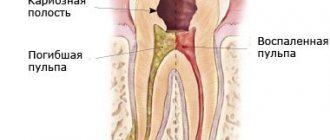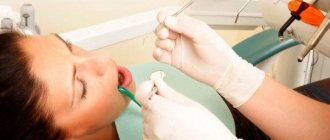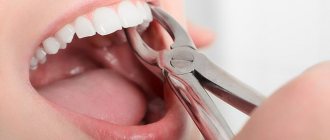For many people, wisdom teeth have difficulty erupting because they do not have enough space in the jaw. In this case, dentists recommend removing them to prevent crooked teeth and other problems. Extraction of third molars is a complex operation that must be performed by a highly qualified dental surgeon.
After surgery, it is important to follow your doctor's recommendations.
- For the first few days after surgery, you should not rinse your mouth or drink through a straw, as this may wash out the blood clot covering the wound.
- Brush your teeth with a soft-bristled brush and eat only soft foods to avoid damaging the socket.
- Minimize physical activity, do not visit the sauna or take a hot bath.
- If the pain is severe, take painkillers. To relieve swelling, you can apply ice to your cheek.
- Stop drinking alcohol and smoking.
It is important to monitor the wound remaining at the site of the extracted tooth until it heals completely.
What does the white coating mean?
Did you find that your gums turned white after wisdom tooth removal? There is no cause for concern as this is normal. White plaque may be on the hole and around it. The reason for its appearance is fibrin, a protein that ensures tissue regeneration. It performs several functions:
- prevents bleeding,
- closes the wound and protects it from bacteria,
- helps reduce the diameter of the hole,
- accelerates the resorption of a blood clot.
White plaque cannot be removed. Because of this, pain increases and the wound healing time increases. Damage to the protective film can lead to severe bleeding and infection of the socket.
White plaque on the gums (candidiasis) –
If your gums turn white, then you can suspect not only leukoplakia, but also oral candidiasis, in which a white coating may appear on the gums, tongue, mucous membranes of the cheeks and palate. Candidiasis is caused by fungi of the genus Candida. Most often it occurs against the background of reduced immunity, endocrine diseases, gastrointestinal diseases, anemia, hypovitaminosis, diabetes mellitus, HIV infection, chronic hepatitis, and smoking.
Long-term use of antibiotics and mouth rinses containing antibiotics and antiseptics can also lead to candidiasis. The presence of untreated carious teeth, inflammation of the gums, and poor oral hygiene also plays a big role in the occurrence of candidiasis.
White plaque on gums: photo
Possible complications
In rare cases, white gums after wisdom tooth removal may indicate the development of complications.
- Alveolitis. Inflammation of the socket due to infection by pathogenic microorganisms. The causes of development include non-compliance with personal hygiene rules and doctor’s recommendations. The main clinical manifestations are throbbing pain, gray plaque on the wound, and swollen lymph nodes.
- Periostitis. Inflammation of soft tissues and periosteum. Develops due to poor quality dental treatment and jaw injuries. It is a small growth on the gum that can be red, yellow or white.
Why you don't need to remove white plaque
Careless performance of oral hygiene procedures can cause damage or removal of the protective film. A number of negative processes result from the destruction of the barrier:
- Opening a wound for access of pathogenic microorganisms that provoke inflammation and infect the body’s circulatory system;
- Increased pain caused by the sensitivity of unprotected tissues to any form of external influence;
- Reopening of bleeding and increasing the duration of healing of the alveolar socket.
Accidental damage can be avoided by following medical recommendations.
How to maintain the integrity of white plaque after tooth extraction?
Reducing the risk of developing complications that occur against the background of exposure of the tooth extraction site involves following the following instructions:
- Abstain from drinking and eating for three hours from the end of the operation;
- Avoiding increased temperature in the affected gum area, including overheating as a result of taking a bath or visiting a sauna;
- Temporary cessation of bad habits, including smoking and drinking alcohol;
- Observe a daily break in relation to the procedure of rinsing the mouth and brushing the teeth;
- Reduce physical activity for the entire recovery period.
In situations where the pain after removal of the unit remains noticeable and causes severe discomfort, it is permissible to take painkillers prescribed by the attending physician. If you detect uncharacteristic discharge, which is a liquid mass, the spread of swelling to the gum tissue, as well as an increase in temperature to 38 degrees, you should immediately seek help, since these symptoms may indirectly indicate the development of infection or complications.
When do you need a doctor's help?
If you experience pain 3-5 days after wisdom tooth removal, you should consult a specialist. Reasons to visit a dentist are also:
- accumulation of pus in the wound,
- bad breath,
- increase in body temperature,
- bleeding gums,
- swelling of the lip or cheek,
- pain when eating.
Don't expect unpleasant symptoms to disappear. Contact your doctor even if you experience minor oral discomfort.
Are white spots on the gums a symptom of rejection?
The following signs indicate the initial stage of rejection:
- pain around the operated area;
- edematous hyperemic mucosa;
- bleeding;
- bad breath.
As the destructive process progresses, the symptoms increase and include:
- pin mobility;
- severe pain syndrome;
- pronounced hyperplastic changes in the gingival contour;
- periodontal pockets;
- fistulous tracts, the purulent contents of which come to the surface through the resulting white sac.
The associated infection is manifested by an increase in body temperature, intoxication, and deterioration of the general condition. Typically, patients with implant failure have regional lymphadenitis.
The appearance of white dots at the site of the implanted titanium root may indicate a purulent process and the presence of fistula tracts , which are signs of rejection.
Why an implant may not take root after installation
- Unprofessionalism or mistake of the implantologist . Lack of experience, inattention, and negligence can lead to serious consequences.
- Poor quality implantation system . Working with direct suppliers allows clinics to avoid purchasing low-quality counterfeits. Small private dentistry does not always have this opportunity, so there is no confidence in the originality of the designs. In addition, high-quality materials are required for manufacturing - the implant cannot be cheap.
- Failure to comply with doctor's recommendations . Any work of a specialist can be reduced to zero by the patient’s incorrect actions during the engraftment period. Deteriorating health also negatively affects implants—rejection can occur even several years after surgery.
What to do to prevent the appearance of white plaque after implantation
You can minimize the risk of white spots and the development of peri-implantitis by following the recommendations of your implantologist.
- Avoid solid food for the first three days after surgery.
- No smoking.
- Massage your gums regularly. This will relieve swelling and improve blood circulation.
- Drink more water.
- Brush your teeth with a soft-bristled brush and children's toothpaste. Do not touch the seam area. Use an irrigator or floss.
- Carefully remove plaque on the gums with a cotton swab.
- Take all prescribed medications and perform the necessary procedures.
How to save an implant during rejection
Correct treatment tactics can stop inflammation within 10-14 days. In case of rejection due to medical error, qualified reimplantation will help. Failure to properly care for the operated area gives an unfavorable prognosis. Reimplantation is not relevant here.
Treatment consists of two stages:
- Medication course. Eliminates the inflammatory process. It is possible to modify the superstructure to redistribute the load on the implant.
- Surgical curettage of the source of infection. Ends with a course of antibiotics and antiseptic rinses.
Timely consultation with a doctor allows you to save the implant. In advanced cases, when treatment does not make sense, the implant is removed. A repeated implantation procedure is possible in a month or two, no later, since in the absence of load on the tissues, their recession begins.
White plaque on teeth near gums
A visit to the dentist quite often begins with the doctor noting plaque deposits on the patient’s teeth. Where does the white plaque on the teeth near the gums come from, how to get rid of it and how to prevent its accumulation? This will be discussed in this article.
Teeth are practically the only part of the human body that does not have a self-regulating system capable of removing old and unnecessary tissue and replacing them with a layer of renewed cells. As a result, entire colonies of microorganisms constantly stick to the surface of the enamel, eating leftover food and oral epithelium, multiplying and gradually increasing the volume of the biofilm. Over time, the composition of the microbiome changes, diseases of teeth and gums develop, and bad breath appears, which cannot be eliminated by simple means. The composition of saliva itself also undergoes changes; its acidity increases, which leads to accelerated destruction of enamel. Dental plaque is a soft substance that adheres to the surface of the teeth in which microorganisms live and multiply. The composition includes minerals from saliva, organic residues, fluid from the gingival groove, live bacteria and their waste products.
When it comes to bacterial composition, it is no coincidence that the oral cavity is called the dirtiest place in the body. Conditions in the oral cavity are favorable for the proliferation of a huge number of varieties of microbes. Scientists have counted about 25 thousand species of bacteria that can live in various parts of the human oral cavity. About a thousand of them live directly in the thickness of dental plaque and are able to adapt to the changing conditions of their environment. It is also worth noting that recent research suggests that bacteria can directly influence the environment, adapting it to their needs, through complex interspecies interactions. A small amount of white plaque in itself is harmless and was designed by nature to protect teeth and gums from the aggressive effects of pathogenic bacteria. However, if the oral cavity is not kept clean and regularly, plaque will accumulate and become deposited, causing it to mineralize (or harden). It is impossible to remove such plaque on your own with a brush and paste; this will require a visit to the dentist, who will clean the teeth using special tools or devices.
Tartar bacteria living closest to the surface of the enamel will begin to use anaerobic respiration (a special type of respiration of bacteria living in conditions without oxygen). After switching to this type of breathing, bacteria produce much more acid. The excretion products of these microorganisms rapidly destroy the enamel, forming carious cavities. The appearance of a strong foul odor from the mouth is also directly related to anaerobes. How to determine the presence of white plaque on teeth? There are several methods for identifying plaque, but only some of them can be used at home.
1) Visual inspection. If plaque is present in sufficient quantities, it can be seen with the naked eye in the form of whitish masses around the surfaces of the teeth. Tartar is located closer to the gum and is often yellowish-gray
2) Scraping with a dental probe or toothpick. By running along the cervical surface of two or three teeth, you can detect plaque residues on the tip of a toothpick. Try not to touch the gum, as it is very easy to injure and become infected, causing local inflammation. This method is useful for self-monitoring the quality of dental hygiene, as well as for checking the cleanliness of children’s teeth when teaching them how to care for the oral cavity.
3) Staining of dental plaque. For this purpose, special solutions or chewable tablets are used. They are only available in dental offices and are not intended for permanent use. After chewing the dye tablet, the soft and hard coating becomes bright, most often red. This method is the most visual, but after it, professional teeth cleaning by a dentist is required, otherwise the stained plaque will remain on the teeth.
4) Application of ultraviolet rays. The method is not inferior in clarity to the previous one, however, the deposits themselves do not change their color in daylight. All you need to do to determine plaque is rinse your mouth with a special composition. Next, the doctor shines an ultraviolet lamp on the teeth and the entire plaque is illuminated in bright orange.
How does white plaque form on teeth?
Mechanisms involved in plaque formation include:
absorption of protein and carbohydrates by bacteria with subsequent formation of a biofilm on the surface of tooth enamel;
electrostatic van der Waals forces, which physically increase plaque adhesion; the so-called “reversible adhesion” of the film to the tooth enamel is formed; a similar phenomenon of “irreversible adhesion” occurs when pellicle (cell membrane) molecules interact with the cell surface;
joint interactions of primary (aerobic) and secondary (anaerobic) bacterial agents that change the environmental conditions inside the plaque for accelerated reproduction and the formation of a film that is difficult to remove.
Soft white plaque on the teeth tends to turn into tartar when several conditions are met simultaneously: dryness in the mouth due to low saliva production or saliva of high viscosity, changes in the acidity level of the oral fluid, maintaining an optimal temperature, an imbalance of redox reactions in the mouth. oral cavity, infrequent or ineffective tooth brushing.
Dental treatment at the AVANTA dental clinic in St. Petersburg.
Our specialists will conduct an initial examination and advise you. We are located next to the Mezhdunarodnaya metro station, at the address: Frunzensky district, Bela Kun street, building 2, building 1.
#dental treatment #dentistry
Gum structure
According to physiological and clinical characteristics, the gums are divided into three zones:
- marginal, which covers the cervical area of the tooth and has a smooth surface. The width of this part is 0.8–2.5 mm;
- attached (alveolar). It is fused with the alveolar bone, has a width of 1–9 mm and is lined with stratified keratinizing epithelium;
- free (marginal), located between the teeth and called “interdental papillae,” which normally have a triangular shape. The area adjacent to the tooth is covered with non-keratinizing epithelium.
The basis of the connective tissue of the gums is made up of cells, proteoglycans, fibers and blood vessels. Collagen fibers ensure tight compression of the gums to the tooth, continuity of the dentition and distribution of the load of chewing pressure. The presence of elastic fibers is observed in the perivascular zones.
Anemia
Anemia occurs when the body does not receive enough blood. Lack of blood can cause some tissues to become pale. In addition to pale gums, other symptoms may appear:
- Unexplained fatigue and weakness;
- Dyspnea;
- Pale or yellowing of the skin and whites of the eyes;
- Headache;
- Cardiopalmus.
Anemia often occurs due to a lack of iron, folic acid, or vitamin B-12. In addition, a person may have too few blood cells or not enough hemoglobin. In people with sickle cell disease, the blood cells are abnormally shaped.











